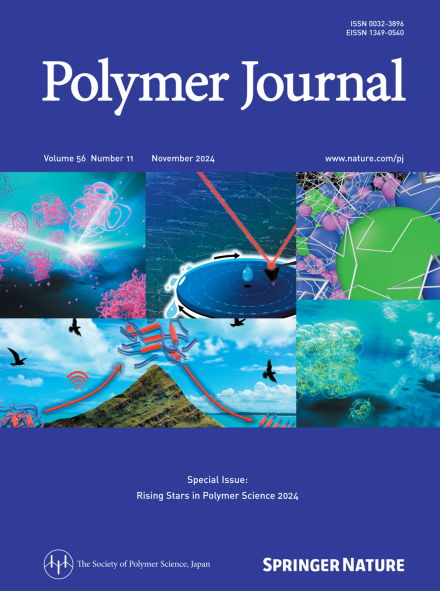Solid base-assisted photocatalytic degradation of polyethylene via the Norrish mechanism through the generation of alternating polyketones
IF 2.7
4区 化学
Q3 POLYMER SCIENCE
引用次数: 0
Abstract
Low-density polyethylene (LDPE) is widely used in plastic products. Due to its nonpolar molecular structure and inert hydrocarbon chains, it is resistant to degradation, leading to serious environmental problems. As a photocatalyst, TiO2 generates electron-hole pairs upon exposure to ultraviolet (UV) light. The holes interact with hydroxide ions $${\left(\right.{\mbox{OH}}}^{-}$$ dissociated from a solid base to produce hydroxyl radicals ( $${}^{\bullet }{{\rm{OH}}}$$ ). These radicals then attack the PE chain, generating carbonyl groups (C=O), which facilitate Norrish reactions and promote PE degradation. In this study, a LDPE-1%TiO2 (LDPE-1T) composite film was first soaked in a NaOH solution to determine its photocatalytic degradation efficiency under alkaline conditions. After 800 h of UV exposure, the film exhibited a significant mass loss of ~87 wt%. In contrast, the LDPE-1T composite film without NaOH pretreatment presented a lower mass loss of ~55 wt%. To increase the applicability of this study, a solid base was incorporated to fabricate LDPE-5%TiO2-3%K2CO3 (LDPE-5T-K) and HDPE-1%TiO2-3%K2CO3 (HDPE-1T-K) composite films through hot pressing. This modification was also shown to increase photocatalytic degradation efficiency by increasing the concentration of $${}^{\bullet }{{\rm{OH}}}$$ radicals in the system, promoting the formation of C=O groups and facilitating the Norrish type I reaction. Caption: In this study, a simple hot-pressing and blending method was utilized to produce polyethylene films, followed by photocatalytic degradation under alkaline conditions with TiO2. During the photocatalytic degradation process, alternating polyketone groups were generated on the polyethylene matrix, promoting Norrish type I reactions and effectively enhancing the photocatalytic degradation efficiency of polyethylene.

固体碱辅助光催化降解聚乙烯通过产生交替聚酮的诺里什机制
低密度聚乙烯(LDPE)广泛应用于塑料制品。由于它的非极性分子结构和惰性烃链,它不易降解,导致严重的环境问题。作为光催化剂,TiO2在紫外线照射下产生电子-空穴对。这些空穴与氢氧根离子相互作用$${\left(\right.{\mbox{OH}}}^{-}$$从固体碱解离产生羟基自由基($${}^{\bullet }{{\rm{OH}}}$$)。然后这些自由基攻击PE链,生成羰基(C=O),促进诺里什反应并促进PE降解。在这项研究中,一个LDPE-1%TiO2 (LDPE-1T) composite film was first soaked in a NaOH solution to determine its photocatalytic degradation efficiency under alkaline conditions. After 800 h of UV exposure, the film exhibited a significant mass loss of ~87 wt%. In contrast, the LDPE-1T composite film without NaOH pretreatment presented a lower mass loss of ~55 wt%. To increase the applicability of this study, a solid base was incorporated to fabricate LDPE-5%TiO2-3%K2CO3 (LDPE-5T-K) and HDPE-1%TiO2-3%K2CO3 (HDPE-1T-K) composite films through hot pressing. This modification was also shown to increase photocatalytic degradation efficiency by increasing the concentration of $${}^{\bullet }{{\rm{OH}}}$$ radicals in the system, promoting the formation of C=O groups and facilitating the Norrish type I reaction. Caption: In this study, a simple hot-pressing and blending method was utilized to produce polyethylene films, followed by photocatalytic degradation under alkaline conditions with TiO2. During the photocatalytic degradation process, alternating polyketone groups were generated on the polyethylene matrix, promoting Norrish type I reactions and effectively enhancing the photocatalytic degradation efficiency of polyethylene.
本文章由计算机程序翻译,如有差异,请以英文原文为准。
求助全文
约1分钟内获得全文
求助全文
来源期刊

Polymer Journal
化学-高分子科学
CiteScore
5.60
自引率
7.10%
发文量
131
审稿时长
2.5 months
期刊介绍:
Polymer Journal promotes research from all aspects of polymer science from anywhere in the world and aims to provide an integrated platform for scientific communication that assists the advancement of polymer science and related fields. The journal publishes Original Articles, Notes, Short Communications and Reviews.
Subject areas and topics of particular interest within the journal''s scope include, but are not limited to, those listed below:
Polymer synthesis and reactions
Polymer structures
Physical properties of polymers
Polymer surface and interfaces
Functional polymers
Supramolecular polymers
Self-assembled materials
Biopolymers and bio-related polymer materials
Polymer engineering.
 求助内容:
求助内容: 应助结果提醒方式:
应助结果提醒方式:


